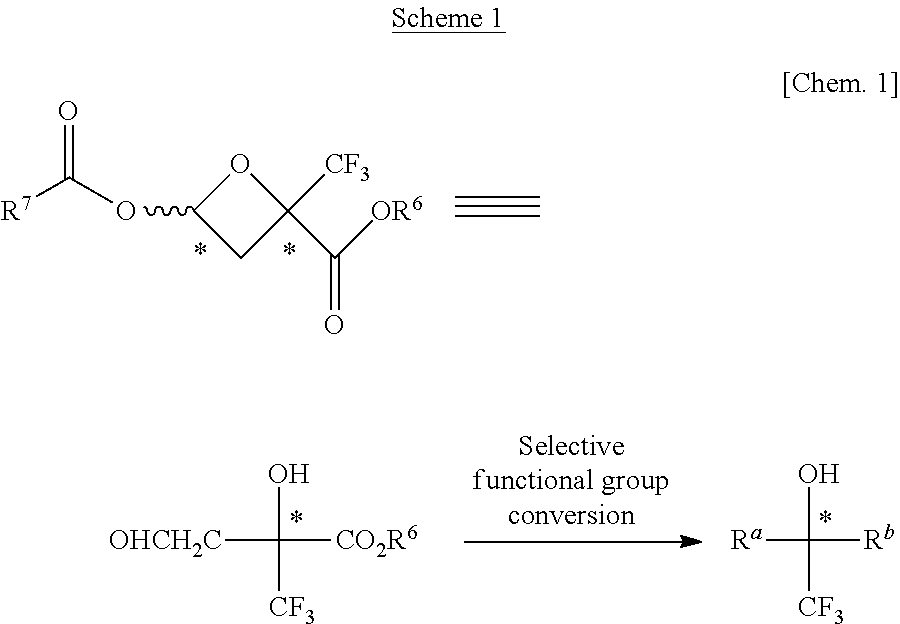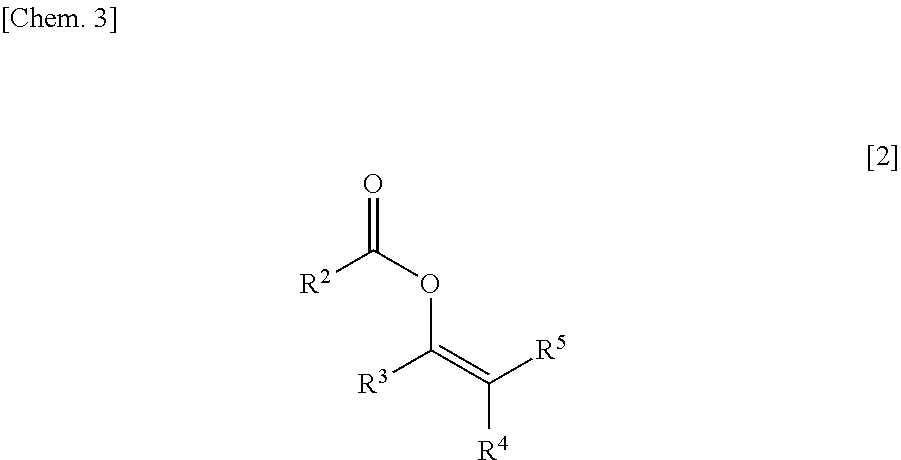Method for producing optically active fluorinated oxetane
a fluorinated oxetane, optically active technology, applied in the direction of organic compounds/hydrides/coordination complex catalysts, physical/chemical process catalysts, organic chemistry, etc., can solve the problem that there are no methods for producing optically active fluorinated oxetan
- Summary
- Abstract
- Description
- Claims
- Application Information
AI Technical Summary
Benefits of technology
Problems solved by technology
Method used
Image
Examples
example 1
[0080]To 1.0 mL of toluene, 8.0 mg (0.01 mmol) of (R)-BINAP-PdCl2 represented by the following formula:
[0081]
and 7.6 mg (0.022 mmol) of AgSbF6 were added in a nitrogen atmosphere. The resulting solution was stirred for 30 minutes at room temperature (to thereby form a divalent cationic transition metal complex with an optically active ligand as represented by the general formula [7] (X—*—X: (R)-BINAP, Y: Pd, Z: SbF6) in the reaction system).
[0082]To the solution, 34.0 mg (0.2 mmol) of fluorinated α-keto ester of the following formula:
[0083]
and 8.6 mg (0.1 mmol) of acyl alkenyl ether of the following formula:
[0084]
were added at −20° C. The solution was then stirred for 15 hours as the same temperature (as a reaction terminated liquid) and treated with the addition of 218 mg (2.2 mmol) of triethylamine.
[0085]The treated reaction solution was directly passed through a short column (silica gel / ethyl acetate:n-hexane=1:1). The filtrate was concentrated under a reduced pressure. The conce...
example 9
[0091]To 1.70 g (10 mmol) of fluorinated α-keto ester of the following formula:
[0092]
4.0 mg (0.005 mmol) of (R)-BINAP-PdCl2 represented by the following formula:
[0093]
and 3.8 mg (0.011 mmol) of AgSbF6 were added in a nitrogen atmosphere. The resulting solution was stirred for 30 minutes at room temperature (to thereby form a divalent cationic transition metal complex with an optically active ligand as represented by the general formula [7] (X—*—X: (R)-BINAP, Y: Pd, Z: SbF6) or a complex of the divalent cationic transition metal complex with the optically active ligand and the fluorinated α-keto ester as represented by the following formula:
[0094]
in the reaction system).
[0095]To the solution, 430 mg (5 mmol) of acyl alkenyl ether of the following formula:
[0096]
was added at −20° C. The solution was then stirred for 48 hours as the same temperature (as a reaction terminated liquid) and treated with the addition of 218 mg (2.2 mmol) of triethylamine.
[0097]The treated reaction solution w...
example 10
[0101]To 5.00 g (29.4 mmol) of fluorinated α-keto ester of the following formula:
[0102]
120 mg (0.150 mmol) of (S)-BINAP-PdCl2 represented by the following formula:
[0103]
and 113 mg (0.329 mmol) of AgSbF6 were added in a nitrogen atmosphere. The resulting solution was stirred for 30 minutes at room temperature (to thereby form a divalent cationic transition metal catalyst with an optically active ligand as represented by the general formula [7] (X—*—X: (S)-BINAP, Y: Pd, Z: SbF6) or a complex of the divalent cationic transition metal complex with the optically active ligand and the fluorinated α-keto ester as represented by the following formula:
[0104]
in the reaction system).
[0105]To the solution, 46.0 g (270 mmol) of fluorinated α-keto ester of the following formula:
[0106]
and 12.9 g (150 mmol) of acyl alkenyl ether of the following formula:
[0107]
were added at −20° C. The solution was then stirred for 48 hours as the same temperature (as a reaction terminated liquid) and treated with t...
PUM
| Property | Measurement | Unit |
|---|---|---|
| optical purity | aaaaa | aaaaa |
| optical purity | aaaaa | aaaaa |
| optical purity | aaaaa | aaaaa |
Abstract
Description
Claims
Application Information
 Login to View More
Login to View More - R&D
- Intellectual Property
- Life Sciences
- Materials
- Tech Scout
- Unparalleled Data Quality
- Higher Quality Content
- 60% Fewer Hallucinations
Browse by: Latest US Patents, China's latest patents, Technical Efficacy Thesaurus, Application Domain, Technology Topic, Popular Technical Reports.
© 2025 PatSnap. All rights reserved.Legal|Privacy policy|Modern Slavery Act Transparency Statement|Sitemap|About US| Contact US: help@patsnap.com



